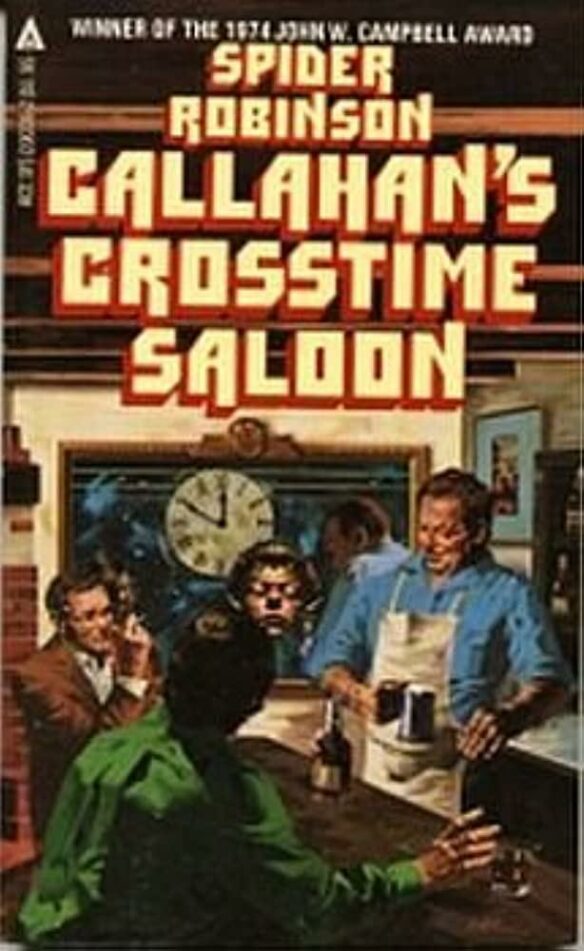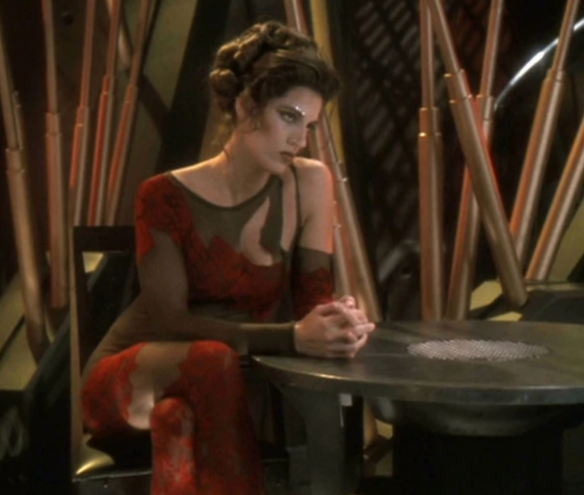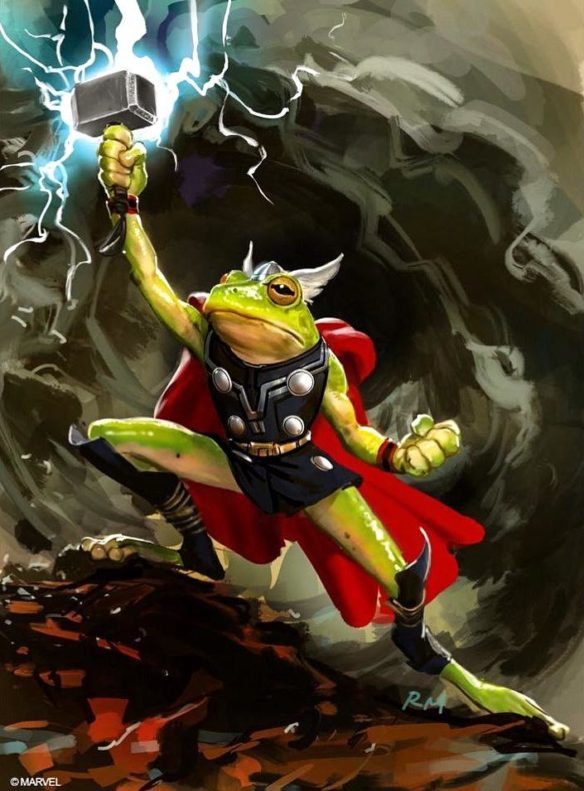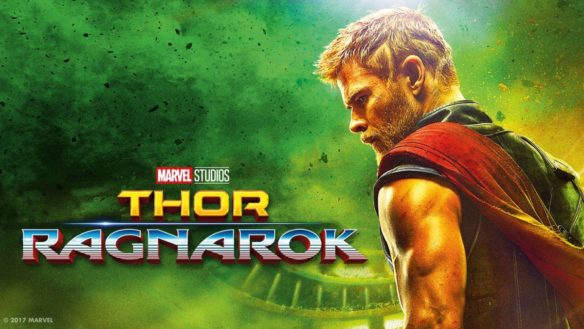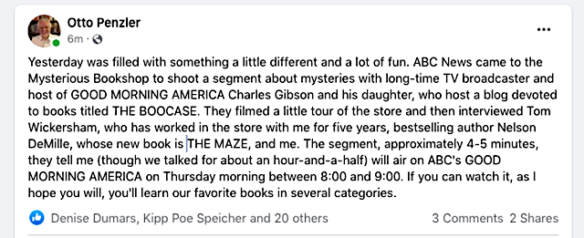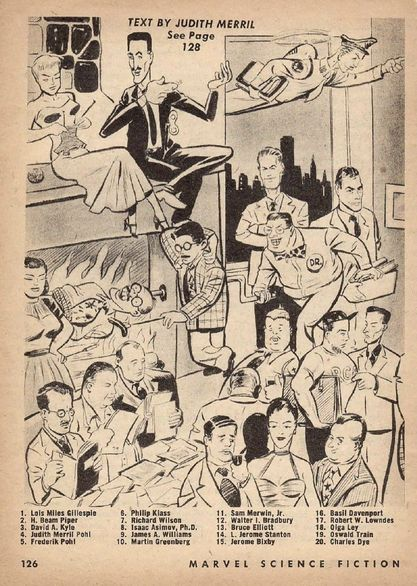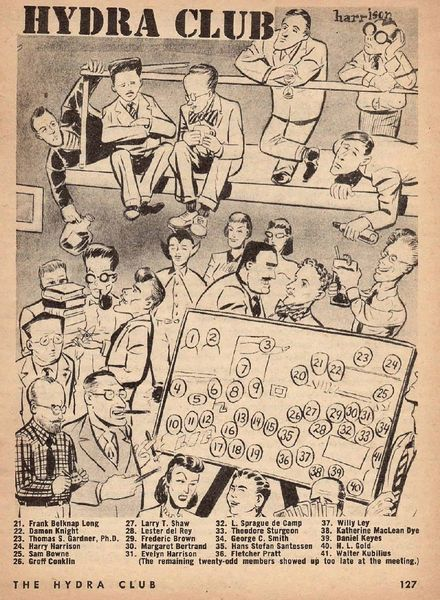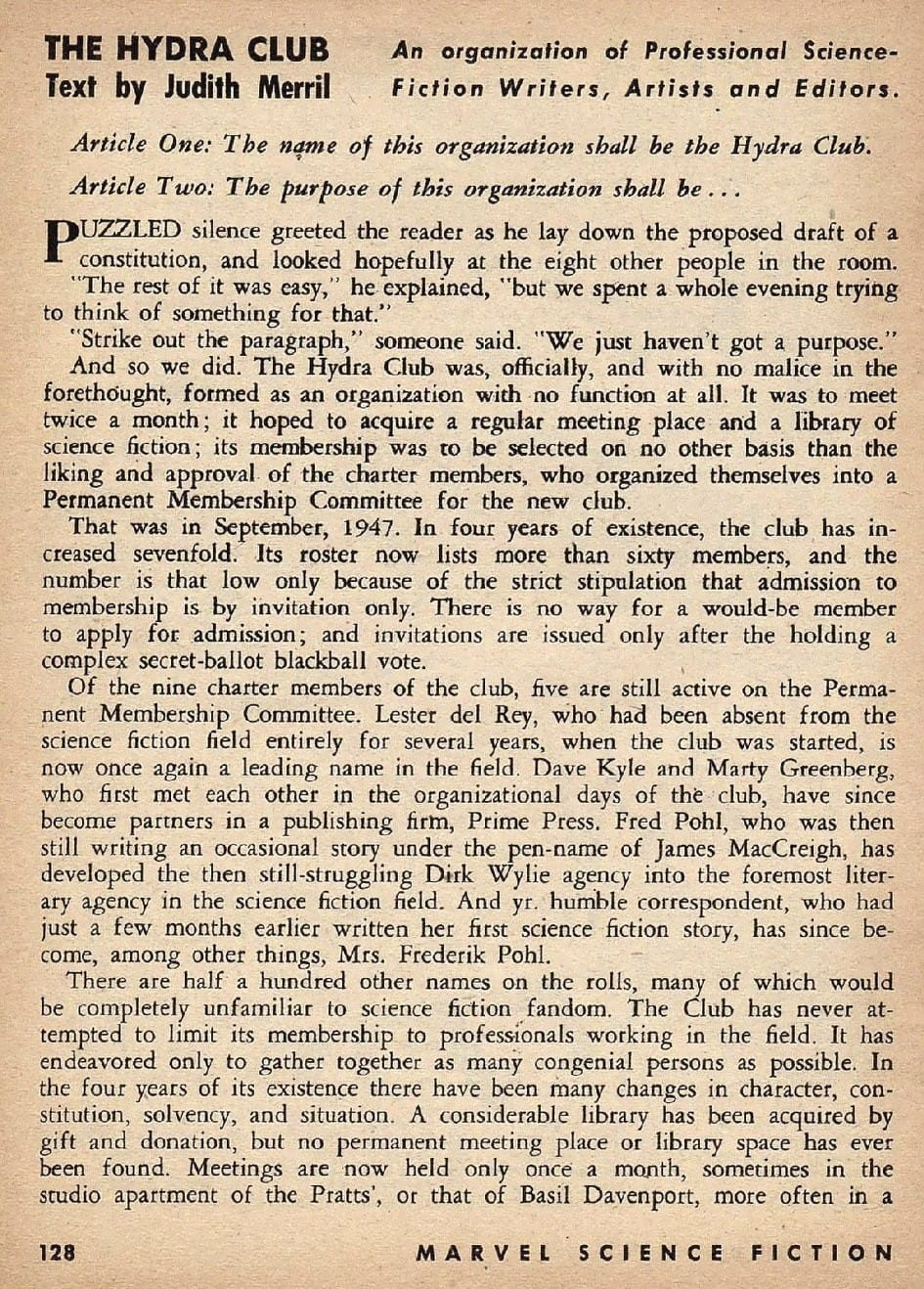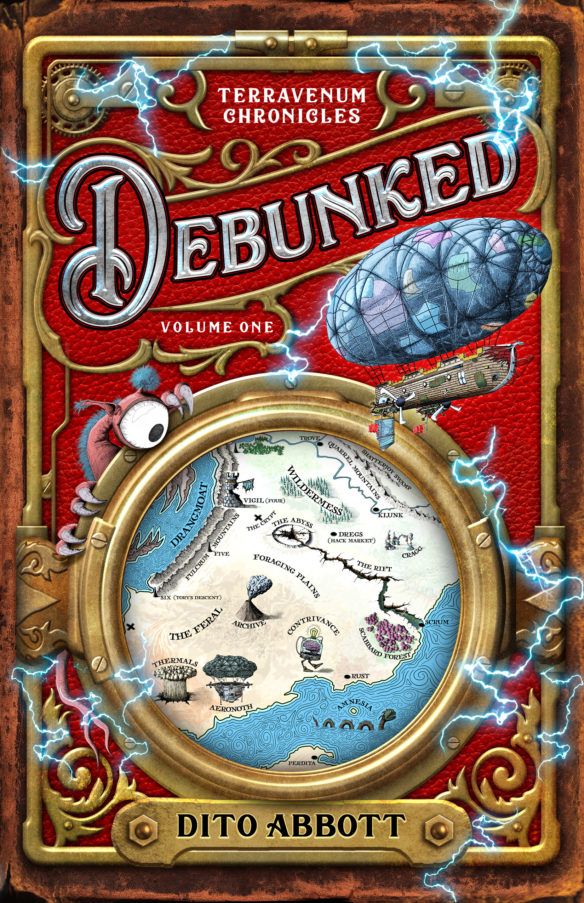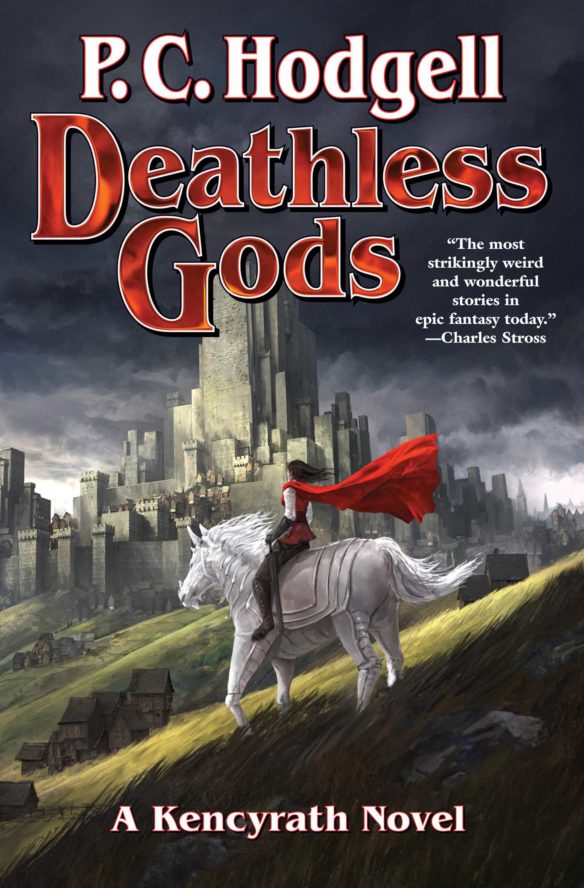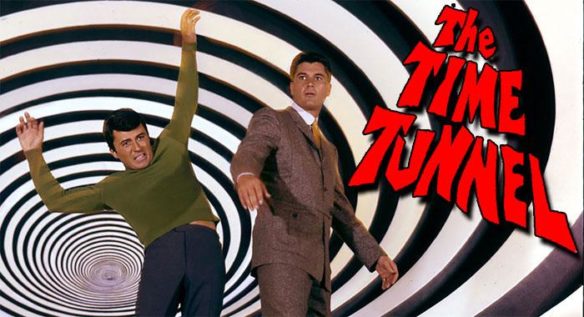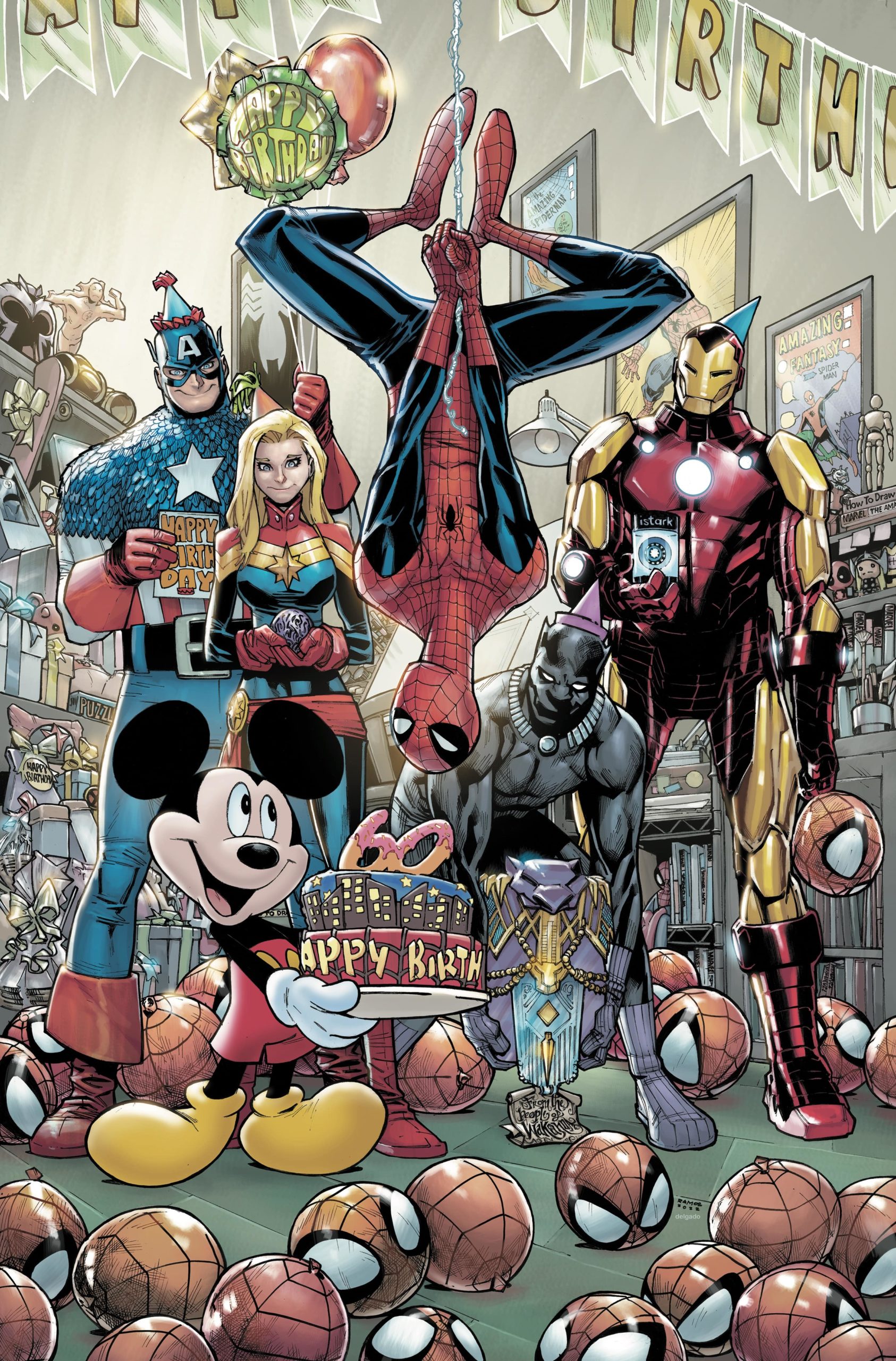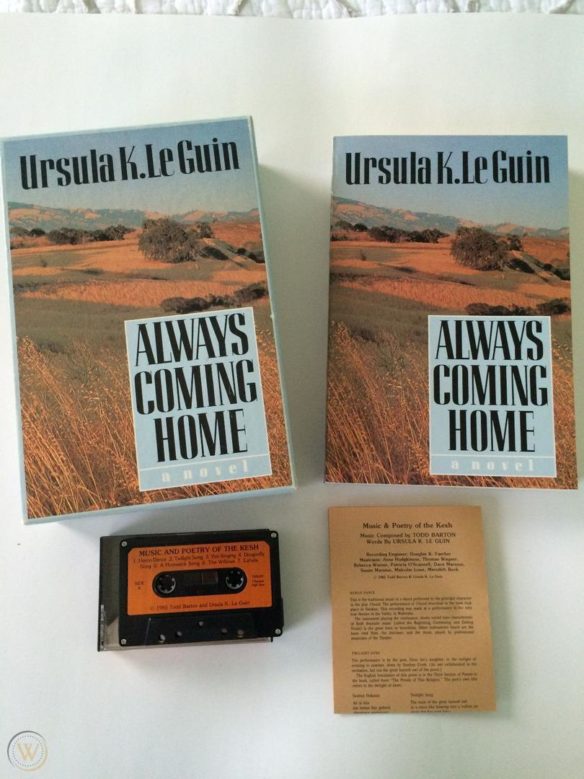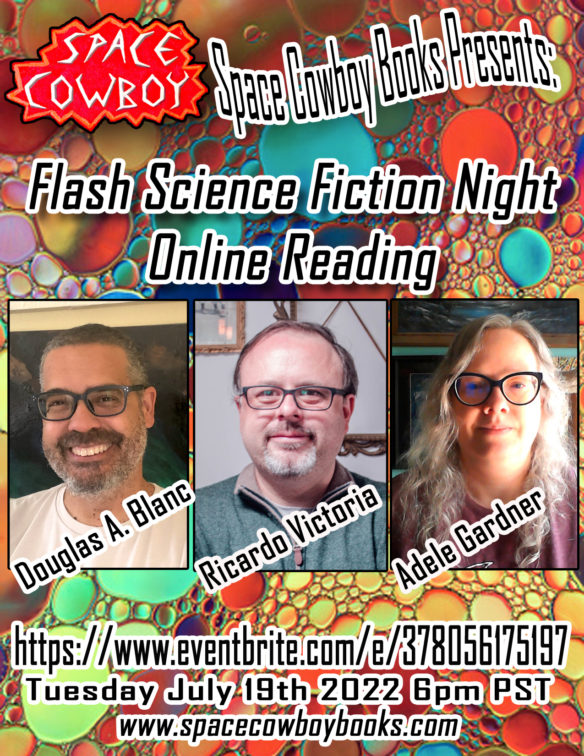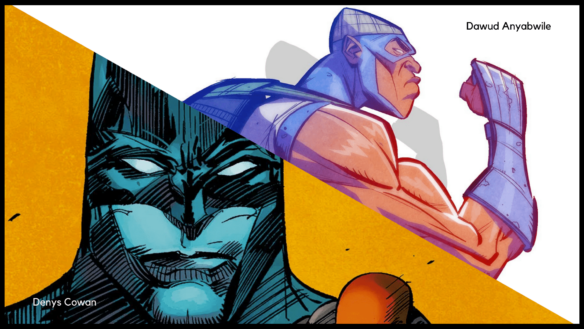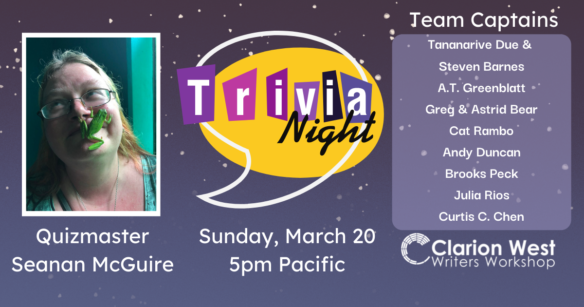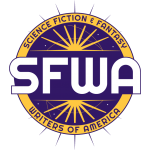(1) FUTURE SF’S ONLINE “ANTHOZINE”. UFO Publishing and Future Affairs Administration has launched a new project they term an “anthozine”.

These stories will appear in The Digital Aesthete: Human Musings on the Intersection of Art and AI hybrid anthology/zine project. They will be published as a book on November 14, 2023, and gradually posted to the Future SF website over the course of the following months.
The antho’s preview story was posted today, Adrian Tchaikovsky’s “Silicon Hearts”.
“Next up is Johnny Zepter.” Steve called up the figures. At her own screen, Kate opened the spreadsheet and readied herself to make notes.
“This week, our good buddy Zee submitted four hundred and seventy-three stories to eight different outlets, of which four were accepted.” Steve nodded in appreciation. “Nice work Jay-Zee. That’s another forty quid in the kitty.”
“One percent takeup,” Kate noted. “We’re hitting the mark nicely there.”
“People’s tastes don’t change, right?” Steve said. Johnny Zepter wrote space adventure. He had a stable of half a dozen two-fisted, square-jawed action types who encountered alien planets or artifacts, defeated the locals with human ingenuity or just by punching them in what they had for faces, discovered something superficially revelatory and made a witty quip about it. Four hundred times this week alone….
Preorder the book via the links at the bottom of the story, or support them via Patreon.
(2) IN THE RUNNING. In the SFWA officer elections, Oghenechovwe Donald Ekpeki is a write-in candidate for director-at-large he told Facebook readers today.
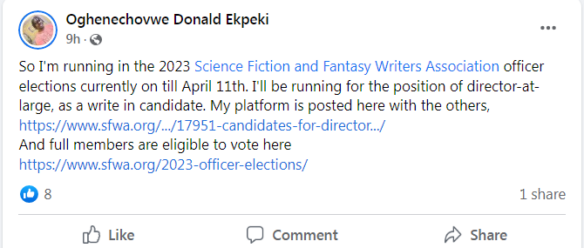
SFWA members have until April 11 to vote in the 2023 Officer Elections.
(3) SO WHAT HAPPENED? Very early Sunday morning during last weekend’s Furnal Equinox convention the committee sent this tweet:

And later that day this update was posted to the convention’s website which only added to the mystery: “March 19, 2023 – Early Morning Disturbance”.
Update: What we know so far..
Early this morning there was an incident near the south tower elevators that created a disturbance which spread throughout the convention level at approximately 2 am.
The events occurred as follows:
• Attendees moved down the escalators away from the south tower
• They moved across the lobby and then back upstairs towards the sky bridge to the convention center
• Hotel security called Toronto Police Services (TPS) immediately following the incident
• The Nightingales responded shortly after hearing the attendees
• Together with the Toronto Police Service, they secured the area
• They then performed a sweep of the area
• A lockdown was initiated, and the gaming lounge was evacuated
• An “all clear” was called within two hours after no immediate threats were located.
The investigation is still ongoing. At this time we do not have more details, but will provide updates as we investigate further. Please allow us to continue to gather information and avoid spreading rumours.
We have been assured that the convention area is safe and Furnal Equinox attendees may enjoy the final day of the event as planned. If you have any concerns now or in the future, please feel free to contact there Nightingales in person or via email at [email protected]. Your health and safety is our top priority.
We would also like to thank the Westin Hotel security team and Toronto Police Service for their quick response and assistance on this matter. And a thank you to all attendees for your cooperation and patience.
So what happened? “Sir Tillfred Laurier” knows, having had some too-personal experience with the offender. Twitter thread starts here.
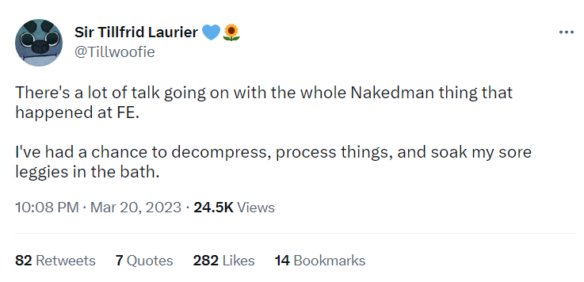
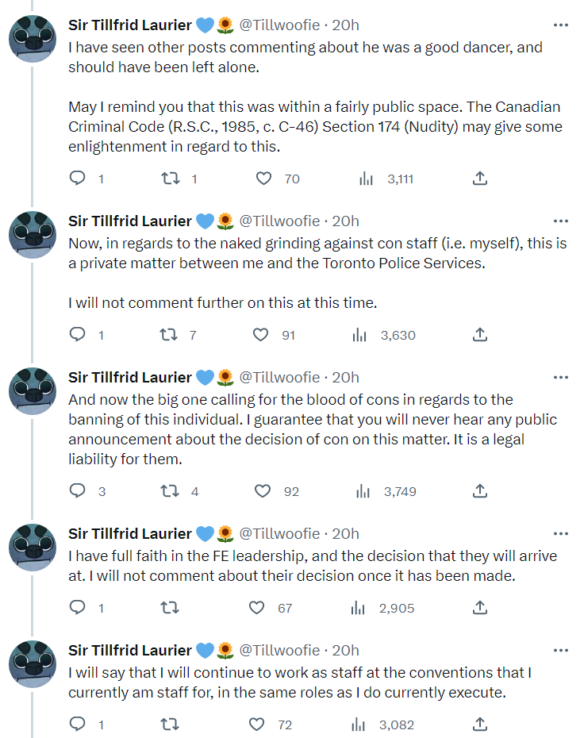
Now have you figured out the answer? There’s video of Nakedman in action on Twitter here. Or there’s a version with “censored” blocks over the peccant parts, plus furry Odin Wolf’s commentary, here.
(4) INDUSTRY PRAISE. Publishing Perspectives reports the “British Book Awards: Trade and ‘Book of the Year’ Shortlists”. Fiction and children’s fiction are strong on genre nominations. The shortlists for those categories are shown below.
…British Book Awards—sometimes called the Nibbies, as the logo reminds us—are a brand of The Bookseller, the United Kingdom’s news medium of record for the publishing industry. There are 29 award categories. …
Fiction
- Love Marriage by Monica Ali (Virago, Little, Brown)
- Stone Blind by Natalie Haynes (Mantle, Pan Macmillan)
- Fairy Tale by Stephen King (Hodder & Stoughton, Hachette)
- Babel by R.F. Kuang (Harper Voyager, HarperCollins)
- The Marriage Portrait by Maggie O’Farrell (Tinder Press, Headline Publishing Group)
- Young Mungo by Douglas Stuart (Picador, Pan Macmillan)
Children’s Fiction
- Diary of a Wimpy Kid: Diper Överlöde by Jeff Kinney (Puffin, Penguin Random House Children’s)
- Onyeka and the Academy of the Sun by Tọlá Okogwu (Simon & Schuster Children’s Books UK)
- Tyger by SF Said, illustrated by Dave McKean (David Fickling Books)
- The First to Die at the End by Adam Silvera (Simon & Schuster Children’s Books UK)
- Skandar and the Unicorn Thief by A.F. Steadman (Simon & Schuster Children’s Books UK)
- Loki: A Bad God’s Guide to Being Good by Louie Stowell (Walker Books)
(5) SWIPER, NO SWIPING. Publishers Weekly reports that “At Hearing, Judge Appears Skeptical of Internet Archive’s Scanning and Lending Program”. He does sound dubious.
After nearly three years of legal wrangling, the Internet Archive’s scanning and lending program finally got its day in court on Monday, March 20. And if Judge John G. Koeltl’s questions are any indication, the Internet Archive is facing an uphill battle.
Over the course of a 90-minute hearing on the parties’ cross motions for summary judgment, Koeltl appeared skeptical that there was sufficient basis in law to support the Internet Archive’s scanning and lending of print library books under a legally untested protocol known as controlled digital lending, and unconvinced that the case is fundamentally about the future of library lending, as Internet Archive attorneys have argued.
“To say that this case is about the ability of a library to lend a book that it owns ignores whether the library has a right to copy wholesale the book,” Koeltl offered at one point during an extended exchange with IA attorney Joseph Gratz. “Does a library have the right to lend a book that it owns? Of course,” the judge conceded. But the question at the heart of this case, he added, is “whether a library has the right to make a digital copy of a book that it owns and then lend that digital copy, which it has made without a license and without permission” to patrons. “To formulate the issue in this case as simply ‘does the library have a right to lend a book that it owns’ belies the issue in the case,” Koeltl said….
… But Koeltl peppered [the Internet Archive’s attorney] Gratz with questions throughout the hearing, appearing deeply skeptical that the Internet Archive’s fair use case was properly supported by case law, and unconvinced that the publishers’ market for library e-books was not impacted by libraries choosing to scan print books under CDL protocols.
“A library whether they hold a physical copy or not, has the ability to license an e-book from a publisher. Rather than pay that licensing fee to the publisher some libraries choose to make their own copy and to lend that copy. Why isn’t it self-evident that that deprives the publisher of the fees that the publisher could otherwise obtain from licensing an e-book to that library?” Koeltl asked.
“It is because with respect to the copies at issue in the CDL situation the question is not between OverDrive and nothing. The question is between physically lending a book to a particular patron, for which no payment would be due to a publisher, or digitally lending that book to the patron,” Gratz replied, adding that to find harm “there would need to be a reason to think that the publishers were worse off than the situation in which in which the fair use did not occur at all.” In fact, library e-book lending has grown throughout the existence of the IA’s scanning program, and actually surged during the height of the pandemic….
(6) GOING PAPERLESS? This news item seems like a parallel issue: “Students speak out about one university’s plans to have a digital-only library” at NPR.
STEVE INSKEEP, HOST:
What’s a library like without books? My kid’s school library removed most of the books, creating a space to use in other ways. And apparently, the university system in Vermont wanted this, too. They proposed taking library books off the shelves of at least three campus libraries and offering digital copies instead. That would save money, but…
ROSIE PHELAN: I was shocked. I was really taken aback when I heard that that was happening.
LEILA FADEL, HOST:
Rosie Phelan is an English major who works in the library at Castleton University. That’s one of three colleges merging to create a new Vermont State University.
PHELAN: You go to a college and you expect to have these resources, and the next thing you know, they’re just taken away.
INSKEEP: Phelan insists students still use physical books….
(7) JEOPARDY! Tonight’s episode of Jeopardy! devoted an entire category to science fiction books. Andrew Porter noted these two entries gave contestants problems.
Category: Books: The Future is Now
Answer: He saw 2024 as a Hellish wasteland in his 1969 short story “A Boy & His Dog”
No one could ask, “Who is Harlan Ellison?”
***
In 2025, game shows are to the death in “The Running Man”, written by Stephen King under this pseudonym
No one could ask, “Who is Richard Bachman?”
(8) TAX SEASON. Lincoln Michel encourages authors to “Write-Off What You Know” at Counter Craft.
Business Income Means Business Deductions
On the one hand, 1099 income seems like a raw deal. You don’t get taxes taken out for you like at a standard job, meaning you owe more at tax time. And you even pay higher taxes in the FICA category. (FICA taxes include Social Security and Medicare. These are paid 50% by your employer and 50% by you. But if you’re a self-employed business, then you pay both halves.)
OTOH, you can and should lower your freelance tax bill with business deductions. Just as a regular company takes deductions, you get to take them as a solo business. The money you can write off lowers the income that is taxed, thus lowering your tax bill….
And from there he goes into more tax return issues.
(9) MEMORY LANE.
1965 – [Compiled by Cat Eldridge.]
Heinlein’s The Moon Is a Harsh Mistress is one of my favorite SF works. I knew it had won a well deserved Hugo at NyCon 3 but I hadn’t realized it was nominated the previous year at Tricon. Isn’t that a tad unusual?
It had been first published in If magazine in five parts starting in the December 1965 issue. It was then published in hardcover by G. P. Putnam’s Sons in 1966. The Penguin Publishing Group has it for sale at the usual suspects as does what I suspect is one pirate publisher as it has no copyright information.
Now I really think that everyone here has read this novel but keeping with our very firm policy of absolutely no spoilers, I won’t say anything beyond the fact that I think that this is one of his best novels and I’ve throughly enjoyed it each and every time I’ve experienced it. Characters, stetting and story — what’s not to really like here?
So now to our most superb Beginning…
I SEE IN Lunaya Pravda that Luna City Council has passed on first reading a bill to examine, license, inspect—and tax—public food vendors operating inside municipal pressure. I see also is to be mass meeting tonight to organize “Sons of Revolution” talk-talk.
My old man taught me two things: “Mind own business” and “Always cut cards.” Politics never tempted me. But on Monday 13 May 2075 I was in computer room of Lunar Authority Complex, visiting with computer boss Mike while other machines whispered among themselves. Mike was not official name; I had nicknamed him for Mycroft Holmes, in a story written by Dr. Watson before he founded IBM. This story character would just sit and think—and that’s what Mike did. Mike was a fair dinkum thinkum, sharpest computer you’ll ever meet.
Not fastest. At Bell Labs, Buenos Aires, down Earthside, they’ve got a thinkum a tenth his size which can answer almost before you ask. But matters whether you get answer in microsecond rather than millisecond as long as correct?
Not that Mike would necessarily give right answer; he wasn’t completely honest.
When Mike was installed in Luna, he was pure thinkum, a flexible logic—“High-Optional, Logical, Multi-Evaluating Supervisor, Mark IV, Mod. L”—a HOLMES FOUR. He computed ballistics for pilotless freighters and controlled their catapult. This kept him busy less than one percent of time and Luna Authority never believed in idle hands. They kept hooking hardware into him—decision-action boxes to let him boss other computers, bank on bank of additional memories, more banks of associational neural nets, another tubful of twelve-digit random numbers, a greatly augmented temporary memory. Human brain has around ten-to-the-tenth neurons. By third year Mike had better than one and a half times that number of neuristors.
And woke up.

(10) TODAY’S BIRTHDAYS.
[Compiled by Cat Eldridge.]
- Born March 21, 1915 — Ian Stuart Black. British screenplay writer best known for scripting two First Doctor stories, “The Savages” and “The War Machines” (with Kit Pedler and Pat Dunlop) and a Third Doctor story, “The Macra Terror”. He wrote thirteen episodes of The Invisible Man as well as episodes of One Step Beyond, The Saint, Star Maidens and Danger Man. (Died 1997.)
- Born March 21, 1931 — Al Williamson. Cartoonist who was best known for his work for EC Comics in the ’50s, including titles like Weird Science and Weird Fantasy, and for his work on Flash Gordon in the Sixties. He won eight Harvey Awards, and an Eisner Hall of Fame Award. (Died 2010.)
- Born March 21, 1936 — Margaret Mahy. New Zealand author of over a hundred children’s and YA books, some with a strong supernatural bent. She won the Carnegie Medal twice for two of her fantasy novels, The Haunting and for The Changeover, something only seven authors have done in total. (Died 2012.)
- Born March 21, 1947 — Terry Dowling, 76. I was trying to remember exactly what it was by him that I read and it turned out to be Amberjack: Tales of Fear and Wonder, an offering from Subterranean Press a decade ago. Oh, it was tasty! If it’s at all representative of his other short stories, he’s a master at them. And I see he’s got just one novel, Clowns at Minnight which I’ve not read. He’s not at all deeply stocked at the usual digital suspects but Kindle has this plus several story collections.
- Born March 21, 1947 — Don Markstein. He was the creator and sole maintainer of Don Markstein’s Toonpedia which is subtitled “A Vast Repository of Toonological Knowledge”. It is an encyclopedia of print cartoons, comic strips and animation started in 2001. He said, “The basic idea is to cover the entire spectrum of American cartoonery.” (Died 2012.)
- Born March 21, 1956 — Teresa Nielsen Hayden, 67. She is a consulting editor for Tor and is best known for Making Light, a blog she shares with her husband Patrick and which may yet resume activity. She is also one of the regular instructors for the Martha’s Vineyard writing workshop Viable Paradise.
- Born March 21, 1970 — Chris Chibnall, 53. A showrunner for Doctor Who and the head writer for the first two (and I think) best series of Torchwood. He first showed up in the Whoverse when he penned the Tenth Doctor story, “42”. He also wrote several episodes of Life on Mars. He’s been nominated for a Hugo three times for work on Doctor Who, “Rosa” at Dublin 2019, “Resolution” CoNZealand and for “Fugitive of the Judoon” at DisCon III.
(11) COMICS SECTION.
- Pickles has an unexpected Star Wars reference.
(12) EVANGELIZING FOR SUPERGIRL. [Item by Olav Rokne.] Some of the comic book nerds in the book club with me have all been quite impressed with Tom King’s latest work Supergirl: Woman of Tomorrow, which James Gunn has listed as the direct inspiration for the upcoming Supergirl movie. It’s eligible for the Hugo this year — and I think it’s something a lot of Worldcon folks would love. Smart, fun, serious, high adventure. “Kara Zor-El Unbound” at the Hugo Book Club Blog.
… These aren’t stories about saving the universe, defeating galactic tyrants, or challenges with world-shattering consequences. But the fact that the stakes are more personal shows what matters to Supergirl, and the human scale of the story makes it highly engaging.
On a technical level, this is a superhero comic book, but the writing takes much of its inspiration from heroic fantasy. This is a story about a sword-wielding hero and sidekick traveling across distant landscapes on a quest and getting pulled into side adventures. Given that it takes cues from the heroic fantasy work of Fritz Leiber, Woman of Tomorrow seems like something that would appeal to many Worldcon attendees….
(13) THEY’VE BEEN HAD. “These Painters Regret Their Dealings With Scam Artists” – and the New York Times introduces them to us.
… It seemed too good to be true — and it was.
What happened next followed a pattern seen in nearly a dozen attempts at defrauding artists of their paintings and money that were reviewed by The New York Times. In each case, young artists were offered an attractive price for artworks by “collectors” who sent them checks to cover the price of the work and the cost of shipping it. Each of them was then asked to forward the shipping fee by money order to a person who was arranging the delivery.
Ginsberg sent $2,060 to the aptly named Linda Shady, who was supposed to be a shipping agent based in Fond du Lac, Wis. That name turned out to be fictitious and the person apparently used fake identification to cash the money order before Ginsberg was told by his bank that the $6,210 check he had received — more than he asked for — had not cleared.
“That was when I realized it was fraud,” Ginsberg said.
Cybercrime experts said fake check scams were growing. Though it did not study art scams per se, a study published in February by the Federal Trade Commission’s Consumer Sentinel Network tallied more than $124 million in damages from more than 40,000 cases involving fraudulent foreign money offers or fake checks.
Most of the cases start with an email from a fictitious person, a subset of the surge in phishing that has greatly increased the vulnerability of communications online. A study by the tech security company SlashNext projected that there were more than 255 million phishing attacks in 2022 through email, mobile and other online channels. That was 61 percent higher than the rate of phishing attacks the company tallied a year before….
(14) BE THE MAN WHO BOUGHT THE MOON (NECKLACE). [Item by Mike Kennedy.] Christie’s is having an online-only auction (closing 28 March) of meteorites & meteorite-related objects. Several of the items have had their origin traced to the Moon, Mars, or a specific asteroid. “Deep Impact: Lunar, Martian, and Other Rare Meteorites”.
Perhaps the crown jewel (so to speak) of the auction is Lot #1—an 18 inch single-strand necklace, consisting of 48 8.25 mm beads derived from Lunar material. One particular asteroid, NWA 12691, has been sectioned for display and sale. Apparently some of the smaller bits from that were formed into these beads.
The estimated price for the necklace is $140,000-$200,000, though the top bid as I write this is a mere $10,000. There are a scant few items in the auction with a higher estimate, but none of those is likely to make as fine a red carpet display.
The catalog description notes:
Fastened with a white gold clasp and knotted when strung, each of these lunar beads are of the highest quality. As is the case with any other lunar feldspathic breccia, each bead is composed of fragments of olivine, pigeonite, augite, ilmenite and signature white anorthite — which is rare on Earth but common on the Moon. The different minerals and lithologies were naturally bound together by a melt of lunar regolith, the result of repeated impacts on the lunar surface prior to the collision responsible for launching NWA 12691 to Earth.
(15) VIDEO OF THE DAY. Honest Trailers does “Everything Everywhere All At Once”, delivering its on-brand snark:
…Stephanie Shu co-stars as their daughter Joy, a character whose complex journey takes her to the edge of madness and back, playing both a teenager struggling to connect with her mom and an omnipotent nihilist seeking to destroy the universe. So of course she lost the Oscar to Jamie Lee Curtis as a mean lady with a funny voice… Let’s just pretend this was a makeup for True Lies….
[Thanks to Chris Barkley, Andrew Porter, Olav Rokne, Kathy Sullivan, Rich Lynch, Alex Shvartsman, Michael Toman, Cat Eldridge, Mike Kennedy, and John King Tarpinian for some of these stories. Title credit belongs to File 770 contributing editor of the day Tom Becker.]

